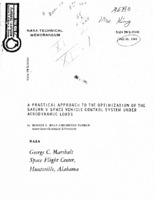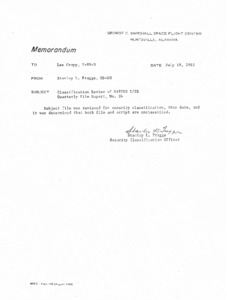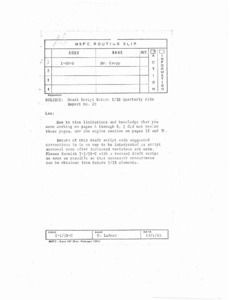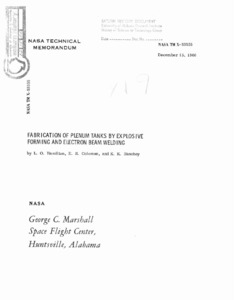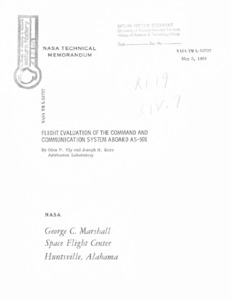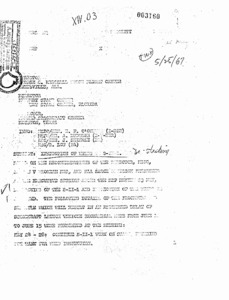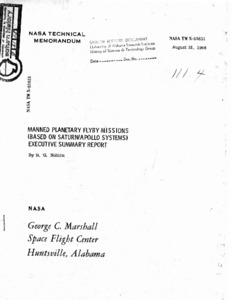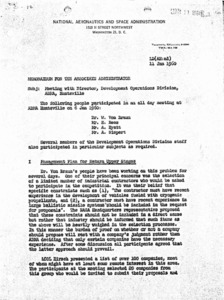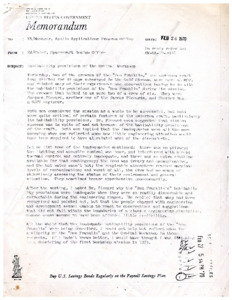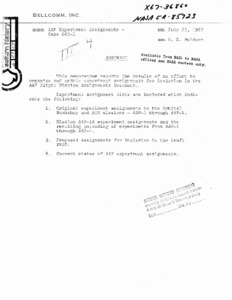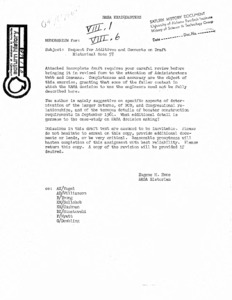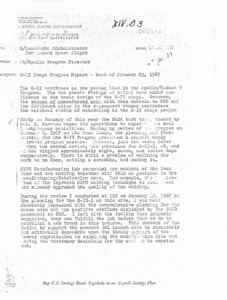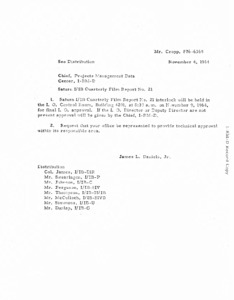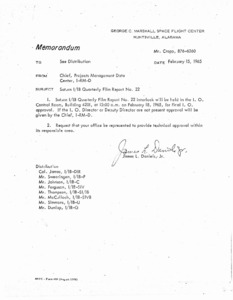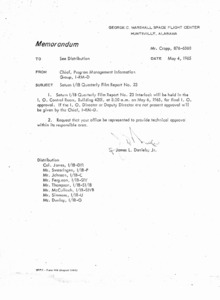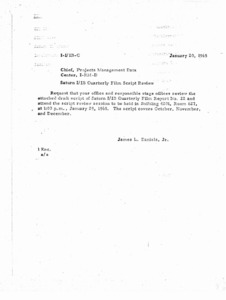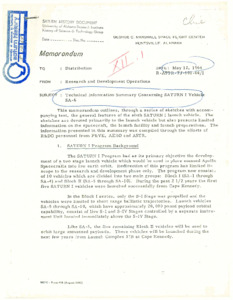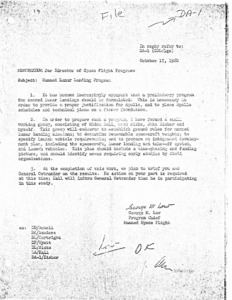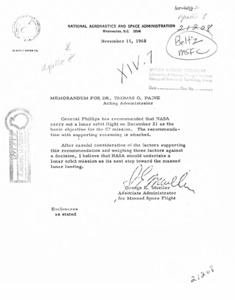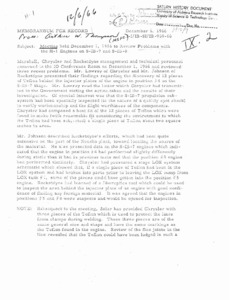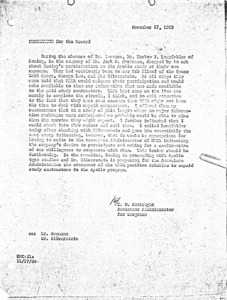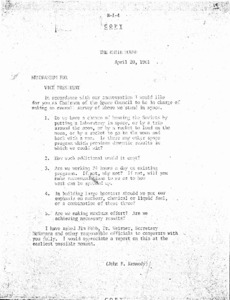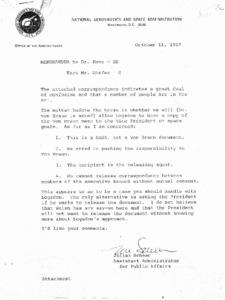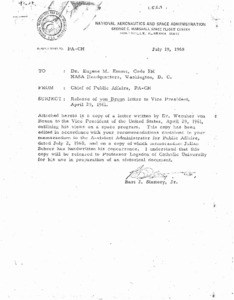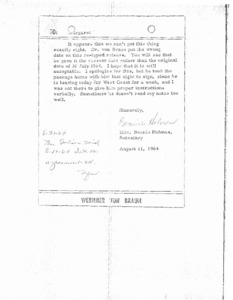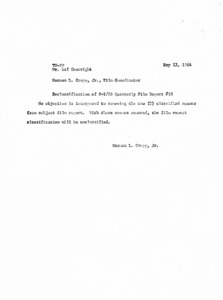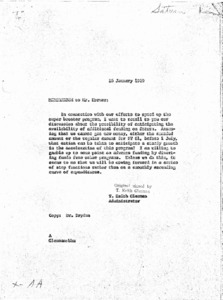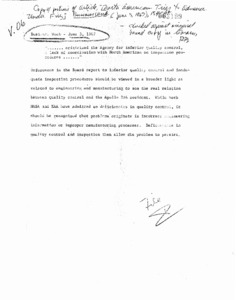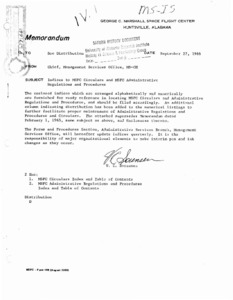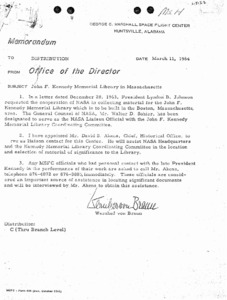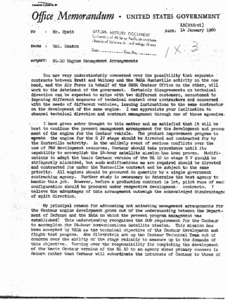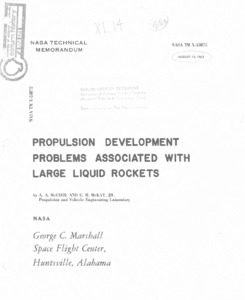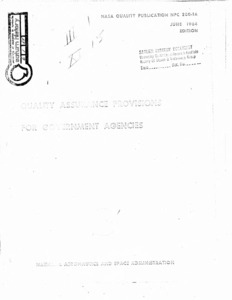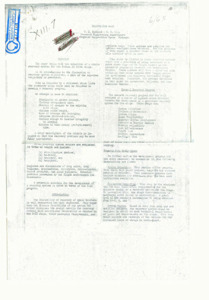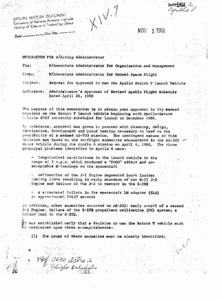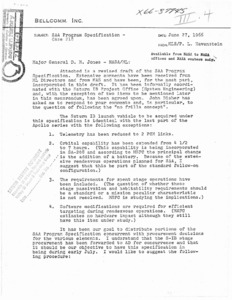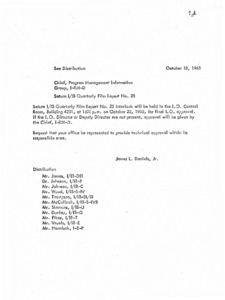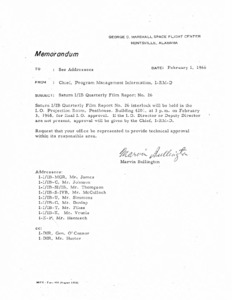
Browse Items (71 total)
Sort by:
-
"A Practical Approach to the Optimization of the Saturn V Space Vehicle Control System Under Aerodynamic Loads."
This paper includes the equations for the bending moment of a launch vehicle with the effects of bending and sloshing dynamics. It also includes a comparison between the bending moment response envelope of the measure winds and the bending moment response of the MSFC synthetic wind profile. -
"Classification review of Saturn I/IB quarterly film report, no. 24."
Memo to Lee Cropp, I-RM-D concerning security classification. -
"Draft script Saturn I/IB quarterly film report no. 25."
MSFC routing slip to Mr. Lee Cropp concerning the draft copy. Contains hand-written editing suggestions, as well as a note that even if these suggestions are applied, that does not imply approval of the script for use. Covers July, August and September, 1965. -
"Fabrication of Plenum Tanks by Explosive Forming and Electron Beam Welding."
This report presents the results of a program initiated to study the use of explosive forming and electron beam fusion welding techniques in the fabrication of pressurized cryogenic materials containers. Using these techniques, vessels were successfully formed from 304 stainless steel and X7106 aluminum alloy in the T63 condition.; Manufacturing Research and Technology Division.; Manufacturing Engineering Laboratory.; Research and Development Operations. -
"First Annual Logistics Management Symposium: September 13 and 14, 1966."
The proceedings of the First Annual Logistics Management Symposium are forwarded with the hope that the information will be of assistance to attendees and their staffs in the planning and management of logistics support programs. I recognize that there is still much study required before all management techniques and procedures for support programs are known and understood, but I believe that support problems are made easier by exchange of knowledge. The Symposium was based on this belief and we plan to continue the search for ways to achieve better program support at a lower cost. Edmund F. O'Connor, Director, Industrial Operations. -
"Flight Evaluation of the Command and Communication System Aboard AS-501."
The first test of the command and communications system, a unified frequency S-band system, aboard AS-501 was successful. Compatibility of this system with the MSFN/USB sites was established. The onboard transponder and antenna system including antenna switching performed as predicted. The command performance was excellent with 5747 valid commands received onboard out of 5748 commands transmitted. Data reduction problems prevented a complete analysis of the tracking data. Telemetry system performance was satisfactory with a measured bit-error-rate of 4 x10-5 while over the Ascension Island station. This flight provided valuable data which can be used to define vehicle to-ground-station interfaces, to establish attitude constraints during translunar injection, and to improve operational procedures. One more test as successful as the AS-501 test would qualify the system as operational.; May 3,1968. -
"Inspection of Welds on S-II-1."
Archive copy is a poor photocopy. Cannot read. -
"Manned planetary flyby missions (based on Saturn/Apollo Systems) : executive summary report."
This report summarizes a study (by North American Aviation, Space Division) of Manned Interplanetary Flyby Missions to Venus and Mars during the period from 1975 to 1982. [The study was a broad but penetrating technical investigation of using a manned flight system for planetary exploration.] The results, along with previously known aspects of manned Mars and Venus flyby missions, vehicles, and systems, were integrated into total mission-system capable of performing a realistic and meaningful planetary exploration program. Manned Planetary Missions are feasible. Attractive multiplanet flyby missions can be performed by Saturn/Apollo systems. However, injected payload and mission requirements developed within the guidelines and assumptions of this study cannot be met with modified S-II or S-IV stages when used with the standard Saturn V Earth-launch vehicle. When using an Earth orbit assembly mode and an uprated Saturn Earth launch vehicle for application to manned planetary flyby missions, the launch vehicle should have a payload capability (2-stage to low Earth orbit) of 400,000 pounds or more for use with M(S)-IVB planetary injection stages. Manned planetary flyby missions provide a means of combining the favorable aspects of both manned and unmanned missions into a unique and highly effective planetary exploration mission-system capable of providing major significant inputs to the scientific and engineering questions concerning the interplanetary medium, our Sun, and our neighboring planets Venus and Mars. -
"Meeting with the Director, Development Operations Division, ABMA, Huntsville : Memorandum for the Associate Administrator."
The following people participated in an all day meeting at ABMA Huntsville on 6 January 1960: Dr. W. Von Braun, Mr. E. Rees, Mr. A. Hyatt, Mr. A. Siepert. Writer of the memorandum is Abraham Hyatt, Deputy Director, Launch Vehicle Programs. -
"Memorandum : AAP experiment assignments - Case 600-1."
This memorandum reports the results of an effort to organize and update experiment assignments for inclusion in the AAP Flight Mission Assignments Document. Experiment assignment lists are included which indicate the following: 1) Original experiment assignments to the Orbital Workshop and ATM missions - AAP-1 through AAP-4; 2) Mission AAP-1A experiment assignments and the resulting unloading of experiments from AAP-1 through AAP-4; 3) Proposed assignments for inclusion in the draft FMAD; 4) Current status of the AAP experiment assignments.; X67-36860.; NASA TR - 85723. -
"Memorandum : request for additives and comments on draft historical note 57."
Memorandum requesting for comments on historical draft note. -
"Memorandum : S-II Stage Program Report from MA/Apollo Program Director to MA/Associate Administrator for Manned Space Flight."
Includes enclosure of S-II Stages Status.; Archive copy is a poor photocopy. -
"Memorandum : Saturn I/IB quarterly film report no. 21."
Memo gives date and time of interlock for final I.O. approval. -
"Memorandum : Saturn I/IB quarterly film report no. 22."
Memorandum includes date and time of interlock for final I.O. approval. -
"Memorandum : Saturn I/IB quarterly film report no. 23."
Memorandum includes date and time for interlock and final I.O. approval.; Archive copy is a photocopy. -
"Memorandum : Saturn I/IB quarterly film script review."
Memorandum pertains to the review draft script. -
"Memorandum : technical information summary concerning Saturn I vehicle SA-6."
This memorandum outlines, through a series of sketches with accompanying text, the general features of the sixth SATURN I launch vehicle. The sketches are devoted primarily to the launch vehicle but also presents limited information on the spacecraft, the launch facility and launch preparations. The information presented in this summary was compiled through the efforts of R&DO personnel from P&VE, AERO and ASTR. -
"Memorandum for Director of Space Flight Programs" related to the "Manned Lunar Landing Program."
Memorandum recommending formulating a "justification" for the Apollo project and and place schedules/plans on a "firmer foundation." -
"Memorandum for Dr. Thomas O. Paine, Acting Director from George E. Mueller, Associate Administrator for Manned Space Flight, dated November 11, 1968."
Memorandum containing a recommendation from General Phillips to continue with the lunar orbit flight scheduled for December. -
"Memorandum for record : meeting to review problems with H-1 engines on S-IB-7 and S-IB-8."
Memorandum to go over problems with the H-1 engine. -
"Memorandum for the record, from E. M. Cortright, Assistant Administrator for Programs."
Poor photocopy. Memorandum informing that members of the Boeing company are coming by for a study of their own. -
"Memorandum for the Vice President from (John F. Kennedy)."
Memorandum from John F. Kennedy to the vice president, wanting to put him in charge of the survey recording their actions in space. -
"Memorandum to Dr. Emme - EH through Mr. Shafter - G from Julian Scheer, Assistant Administrator for Public Affairs, National Aeronautics and Space Administration."
This attached correspondence indicates a great deal of confusion and that a number of people are in the act. The matter before the house is whether we will (Dr. von Braun is asked) to allow Logsdon to have a copy of the Von Braun memo to the Vice President on space goals. -
"Memorandum to Dr. Eugene M. Emme, Code EH, NASA Headquarters, Washington, D. C. from Bart J. Slattery, Jr., Chief of Public Affairs."
Memorandum from NASA Chief of Public Affairs to Eugine M. Emme. States that a video from Wernher von Braun are included regarding his views on the NASA program. -
"Memorandum to Margaret from Mrs. Bonnie Holmes, Secretary."
Memorandum apologizing for the wrong date placed on a previous memorandum. -
"Memorandum to Mr. Hal Seawright, TS-PP, from Norman L. Cropp, Jr., Film Coordinator. Declassification of S-I/IB quarterly film report #18."
Memorandum declassifying "Quarterly Film Report #18." -
"Memorandum to Mr. Horner from T. Keith Glennan, Administrator."
Memorandum discussing possibilities of obtaining or reallocating funding to speed up the 'super booster' program. -
"Memorandum, routing slip, and letter by Harold G. Russell, Colonel, USAF, concerning the Business Week article 'North American tries to advance under fire.'"
This document also contains part of the Business Week article "North American tries to advance under fire", (June 3, 1967) pages 154 to 162. The complete article can be found at the UAH Library in microfilm format.; The document has handwritten notes and is a poor photocopy. -
"Memorandum: Indices to MSFC circulars and MSFC Administration regulations and procedures from Chief Management Services Office."
Memorandum regarding indices ready for reference and filing. -
"Memorandum: John F. Kennedy Memorial Library in Massachusetts."
Memorandum from Wernher von Braun regarding a request made for NASA's cooperation to obtain resources from the Kennedy Memorial Library. -
"Office memorandum : United States Government : RL-10 engine management arrangements."
Memorandum regarding potential arguements and disagreements over the technical direction between two "customers." -
"Propulsion development problems associated with large liquid rockets."
NASA technical memorandum, Propulsion and Mechanism Branch. Propulsion and Vehicle Engineering Division, Research and Development Operations. -
"Quality assurance provisions for government agencies."
NASA Quality publication that contains requirements designed to facilitate the execution of programs effectively. -
"Recoverable S-IB."
The paper deals with the selection of a simple recovery system for the Saturn IB first stage. As an introduction to the discussion on recovery system objectives, a plot of the expected trajectory is presented. This is followed by a statement which lists the necessary steps which must be followed to develop a recovery program. -
"Request for approval to man the Apollo Saturn V Vehicle."
The purpose of this memorandum is to obtaln your approval to fly manned missions on the Saturn V launch vehicle beginning with Apollo-Saturn vehicle #503 currently scheduled for launch in December 1968. -
"SAA program specification - case 218."
Memo sent to Major General D. M. Jones - NASA/ML. -
"Saturn I/IB quarterly film report no. 24."
Gives dates and time of interlock for final I.O. approval. -
"Saturn I/IB quarterly film report no. 25."
Memo gives dates and times of the interlock for final I.O. approval. -
"Saturn I/IB quarterly film report no. 26."
Memo is from Chief, Program Management Information, I-RM-D.; The date and time of the interlock for the final I.O. approval is given.
